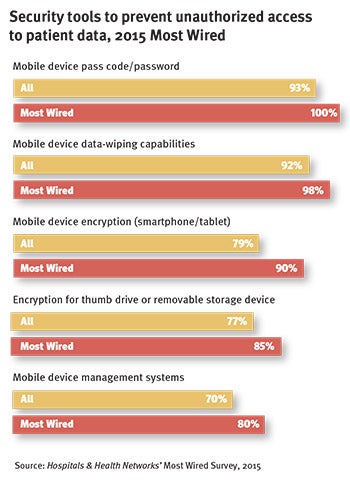Most Wired survey shows methods hospitals take to protect patient information
 Hospitals like Penn Medicine, Philadelphia, are among a growing number of health care facilities that have made it possible for staff and patients to access electronic health records with mobile devices.
Hospitals like Penn Medicine, Philadelphia, are among a growing number of health care facilities that have made it possible for staff and patients to access electronic health records with mobile devices.
“We have been able to provide our clinical community with critical patient data via a variety of media to enhance patient care and smooth transitions,” says Michael Restuccia, vice president and chief information officer, Penn Medicine.
However, easier access to confidential medical information on the proliferation of patients’ and clinicians’ mobile devices has led to an increased focus on maintaining the security of the records on those devices.
Already, 79 percent of all surveyed hospitals and 89 percent of Most Wired-ranked health systems offer portal access through a mobile application, according to the 2015 Most Wired Survey on U.S. hospital and health system IT adoption published in the July 2015 issue of Hospitals & Health Networks magazine.
According to the 2015 Most Wired survey, 100 percent of Most Wired hospitals and 93 percent of all hospitals surveyed require use of a pass code or password to access confidential patient information.
The survey also reported that mobile device data-wiping capabilities are used by 98 percent of Most Wired Hospitals and 92 percent of all hospitals. Additionally, mobile device encryption is used by 90 percent of Most Wired hospitals and 79 percent of all hospitals, according to the survey.
Health care systems can take a number of steps to prevent unauthorized access to patient data, including:
• Putting into place governance policies for mobile devices, mobile storage and mobile applications for internal and external use by employees and business partners, and external delivery to patients and other care providers.
• Providing training on proper use, security and risk of mobile computing devices for all employees.
• Secure applications deployed to a mobile device by employing an authentication mechanism within the application.
• Reducing risk of communications in transit over public networks with up-to-date encryption technologies. When sending patient health information to mobile applications, encrypt data in transit.
For the full 2015 Most Wired report, go to www.hhnmag.com/articles/3325-most-wired-hospitals.




